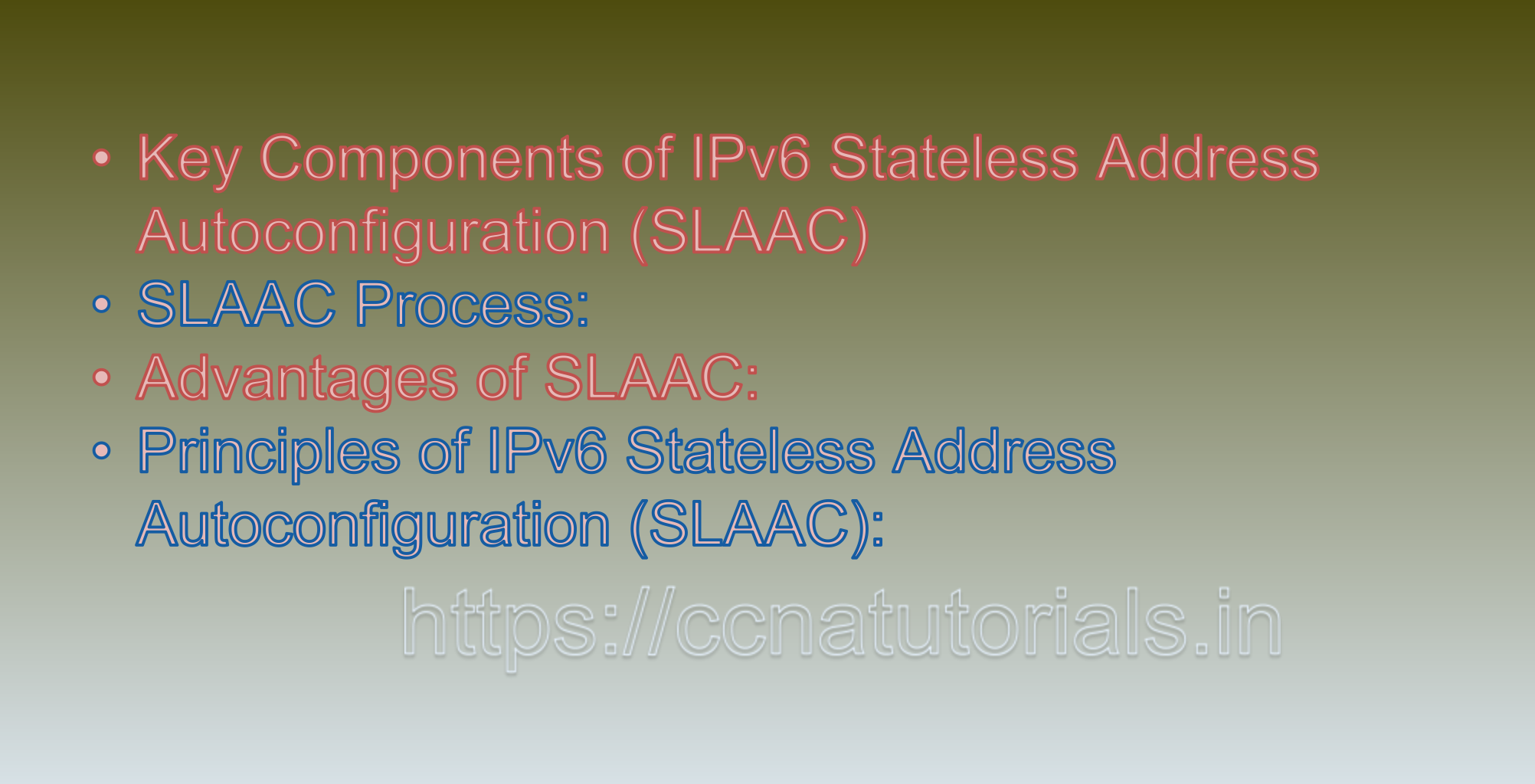Contents of this article
In this article, I describe IPV6 configuration method IPv6 Stateless Address Autoconfiguration (SLAAC). IPv6 Stateless Address Autoconfiguration (SLAAC) is a fundamental mechanism that allows devices to automatically configure their own IPv6 addresses and other network parameters without the need for manual configuration or a central DHCP server. SLAAC simplifies the process of address assignment and enhances the efficiency of IPv6 networks. In this explanation, we’ll delve into the details of IPv6 Stateless Address Autoconfiguration (SLAAC), its components, and how it works.
Key Components of IPv6 Stateless Address Autoconfiguration (SLAAC)
1. Router Advertisement (RA) Messages:
SLAAC relies on Router Advertisement (RA) messages, which are periodically sent by routers on the network. These messages contain essential information that hosts use to configure their IPv6 addresses.
2. Prefix:
The RA messages include the IPv6 prefix that hosts use to construct their addresses. The prefix is the network portion of the address that remains constant across devices on the same subnet.
3. Interface Identifier:
The interface identifier is the unique portion of the IPv6 address generated by the host. It can be derived from the device’s MAC address or using privacy extensions to enhance security.
4. Valid and Preferred Lifetimes:
The RA messages provide information about the validity and preferred lifetime of the IPv6 address. Hosts use this information to manage their addresses, initiate address renewal, and decide when to switch to a new address.
SLAAC Process:
The IPv6 Stateless Address Autoconfiguration (SLAAC) process involves the following steps:
1. RA Messages:
Routers on the network periodically send out Router Advertisement (RA) messages. These messages are usually part of the Neighbor Discovery Protocol (NDP).
2. Address Configuration:
When a device receives an RA message, it extracts the prefix information and combines it with its own unique interface identifier. This creates a complete IPv6 address.
3. Duplicate Address Detection (DAD):
Before using the configured address, the device performs Duplicate Address Detection (DAD) to ensure that the address is not already in use on the network. If the address is unique, the device proceeds to use it.
4. Address Lifetimes:
The RA messages include address lifetimes: valid and preferred lifetimes. The valid lifetime indicates how long the address is valid, while the preferred lifetime indicates how long the address is preferred for new communication.
5. Address Renewal and Expiry:
As the address’s preferred lifetime approaches expiry, the device may initiate address renewal or generate a new address. After the valid lifetime expires, the address is no longer used.
Privacy Extensions:
To enhance privacy and security, IPv6 introduces privacy extensions, which allow devices to generate temporary, random interface identifiers in addition to their permanent ones. These temporary addresses change over time, making it more challenging to track devices based on their addresses.
Advantages of SLAAC:
1. Automation:
SLAAC simplifies address configuration, reducing the need for manual intervention on individual devices.
2. Efficiency:
It minimizes network traffic by decreasing reliance on DHCP server interactions.
3. Network Resilience:
If the central DHCP server is unavailable, devices can still configure their addresses using SLAAC.
4. Scalability:
SLAAC scales well in large networks, as devices can autonomously configure addresses without overloading the network.
IPv6 Stateless Address Autoconfiguration (SLAAC)
IPv6 Stateless Address Autoconfiguration (SLAAC) is a powerful mechanism that simplifies and automates the process of configuring IPv6 addresses on devices. By leveraging Router Advertisement messages and combining prefixes with interface identifiers, devices can autonomously generate unique addresses. With the added privacy extensions, SLAAC enhances security and ensures efficient address management in IPv6 networks, contributing to a seamless and streamlined network experience.
IPv6 Stateless Address Autoconfiguration (SLAAC) via other approach
Stateless Address Autoconfiguration (SLAAC) is a key feature of IPv6 that enables devices to automatically configure their own unique IPv6 addresses without the need for manual configuration or the involvement of a central server. SLAAC simplifies the process of assigning addresses and allows devices to connect to IPv6 networks seamlessly. Let’s explore the principles, benefits, and implementation of SLAAC in more detail.
Principles of IPv6 Stateless Address Autoconfiguration (SLAAC):
IPv6 Stateless Address Autoconfiguration (SLAAC) operates based on the information provided by routers on the network through Router Advertisement (RA) messages. These messages include the IPv6 prefix and other configuration parameters necessary for devices to generate their own addresses. The process involves the following steps:
1. Router Advertisement (RA):
Routers periodically send RA messages to the local network, announcing the network’s IPv6 prefix and other relevant information.
2. Interface Identifier:
Devices use their interface identifier, often derived from their MAC address or using Privacy Extensions, to create a unique identifier.
3. Address Formation:
The device combines the network prefix received from the RA message with the generated interface identifier to form a complete IPv6 address.
4. Lifetime Management:
RA messages also include information about the address’s validity and preferred lifetime. This helps devices manage and update their addresses as necessary.
Benefits of IPv6 Stateless Address Autoconfiguration (SLAAC):
1. Automation:
SLAAC eliminates the need for manual address configuration, reducing administrative overhead and potential human errors.
2. Scalability:
SLAAC is well-suited for networks with a large number of devices since addresses are generated locally without relying on a central server.
3. Efficiency:
The process of address assignment is efficient, as devices can configure their addresses based on readily available information.
4. Simplicity:
SLAAC simplifies the process of onboarding new devices to a network, making it ideal for environments with frequent device additions.
Implementing IPv6 Stateless Address Autoconfiguration (SLAAC):
Implementing IPv6 Stateless Address Autoconfiguration (SLAAC) involves ensuring that your network routers are configured to send Router Advertisement (RA) messages with the necessary prefix information. Here’s a general guide:
1. Router Configuration:
Routers need to be configured to send RA messages. This can be done through router configuration interfaces, such as Cisco IOS, Juniper JunOS, or open-source router software like radvd.
2. Prefix Information:
In the RA messages, include the IPv6 prefix of the network segment where the router is located. The prefix will be used by devices for address formation.
3. Network Devices:
Configure network devices (such as computers, smartphones, and other IPv6-capable devices) to have their network interfaces set to automatically configure using SLAAC.
4. Network Testing:
Verify that devices are correctly receiving the RA messages and configuring their IPv6 addresses based on the provided prefix.
Privacy Extensions:
Privacy Extensions enhance privacy by generating temporary addresses for outgoing connections. These temporary addresses change over time, making it more challenging for tracking activities based on IP addresses. Many modern operating systems support Privacy Extensions by default.
Security Considerations:
While SLAAC is efficient and convenient, it’s essential to consider security aspects. For example, securing router advertisements to prevent unauthorized devices from announcing incorrect prefixes is crucial. Additionally, Network Access Control (NAC) mechanisms should be in place to ensure that only authorized devices can join the network.
In conclusion, Stateless Address Autoconfiguration (SLAAC) is a core feature of IPv6 that simplifies the process of assigning addresses to devices in a network. By relying on Router Advertisement (RA) messages and local address formation, SLAAC enhances automation, scalability, and efficiency in IPv6 networks. Proper implementation and security measures ensure a seamless and secure IPv6 network environment.

IPv6 Stateless Address Autoconfiguration (SLAAC) via other approach
Stateless Address Autoconfiguration (SLAAC) is a fundamental feature of the IPv6 protocol that simplifies the process of assigning and configuring IPv6 addresses on devices within a network. SLAAC allows devices to automatically generate their own IPv6 addresses and obtain other necessary configuration parameters without the need for manual intervention or a central server. It is a key component of IPv6’s design to streamline address assignment and network setup. In this guide, we’ll explore the concept of SLAAC, how it works, and its benefits.
How SLAAC Works:
SLAAC operates based on Router Advertisement (RA) messages sent by routers on the network. These messages provide essential information that devices need for address configuration:
1. Router Advertisement (RA) Messages:
Routers periodically send RA messages on the local network to announce various network parameters, including the IPv6 prefix that devices should use.
2. Network Prefix:
The IPv6 prefix is a portion of the IPv6 address that represents the network portion. It is usually provided by the router in the RA message.
3. Interface Identifier:
Devices generate a unique interface identifier for themselves. This identifier is typically derived from the device’s Media Access Control (MAC) address or using Privacy Extensions to enhance address privacy.
4. Combining Prefix and Interface Identifier:
Devices combine the received IPv6 prefix with their unique interface identifier to form a complete IPv6 address.
Benefits of SLAAC:
1. Automated Configuration:
SLAAC eliminates the need for manual address configuration on each device, reducing administrative overhead.
2. Simplified Network Setup:
Devices can be connected to the network and obtain addresses without requiring extensive configuration.
3. Efficient Address Utilization:
SLAAC allows devices to generate addresses based on network information, ensuring efficient utilization of the IPv6 address space.
4. Reduced Network Traffic:
SLAAC reduces network traffic by minimizing the reliance on a central server for address assignment.
Privacy Extensions:
To enhance privacy, IPv6 introduces Privacy Extensions as part of SLAAC. Privacy Extensions allow devices to generate temporary and frequently changing interface identifiers. These temporary addresses help prevent device tracking based on static interface identifiers.
Example of SLAAC Configuration:
Assume you have a router on the network that sends out RA messages and announces the prefix `2001:0db8:1234:abcd::/64`.
1. A device receives the RA message with the prefix `2001:0db8:1234:abcd::/64`.
2. The device generates a unique interface identifier, which could be derived from its MAC address or Privacy Extensions.
3. The device combines the prefix and interface identifier to create a complete IPv6 address:
2001:0db8:1234:abcd::generated-interface-identifier
SLAAC and Additional Configuration:
While SLAAC provides IPv6 addresses, it does not provide additional configuration parameters, such as DNS server addresses or domain names. In scenarios where more comprehensive configuration is needed, networks can use a combination of SLAAC and Dynamic Host Configuration Protocol for IPv6 (DHCPv6).
Conclusion for IPv6 Stateless Address Autoconfiguration (SLAAC):
Stateless Address Autoconfiguration (SLAAC) is a crucial mechanism in IPv6 networks that simplifies the process of assigning and configuring IPv6 addresses on devices. By leveraging RA messages and network prefixes, SLAAC enables automated address assignment, streamlined network setup, and efficient address utilization. It’s an integral part of IPv6’s design philosophy to support the evolving demands of the modern digital landscape. You may drop a comment below or contact us for any queries or suggestions related to this article.






